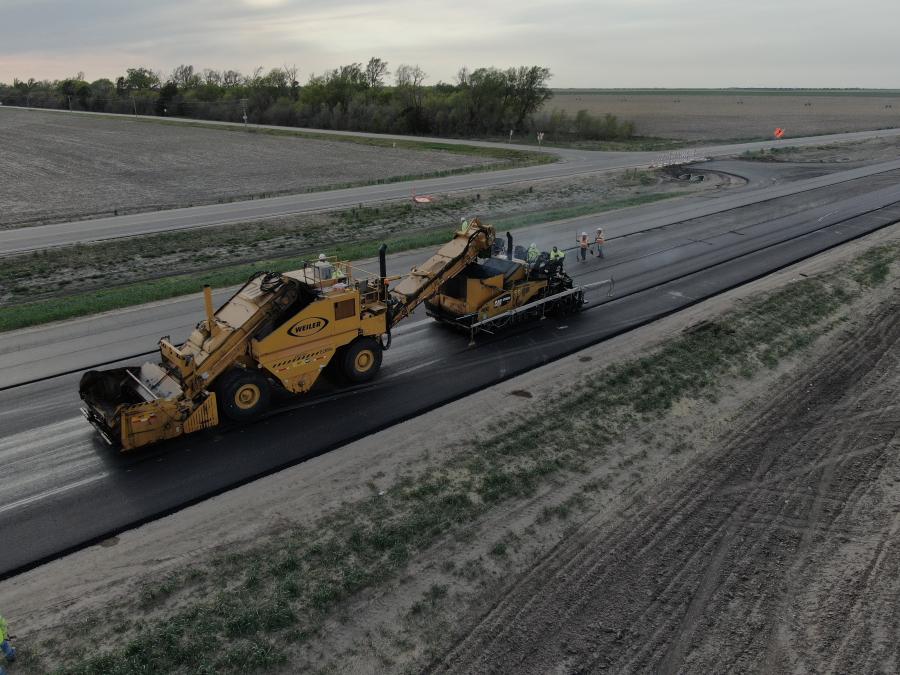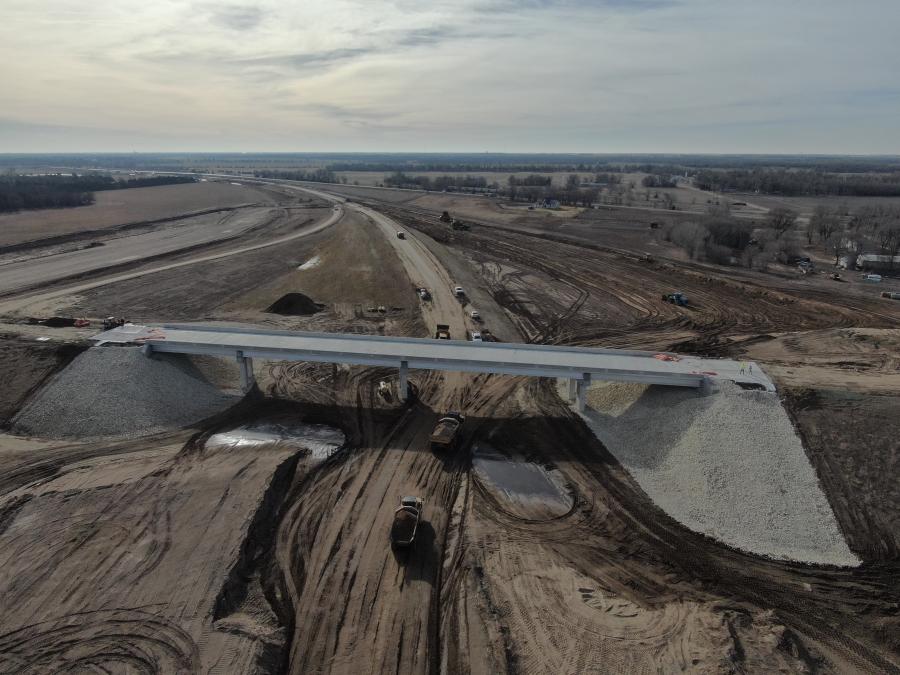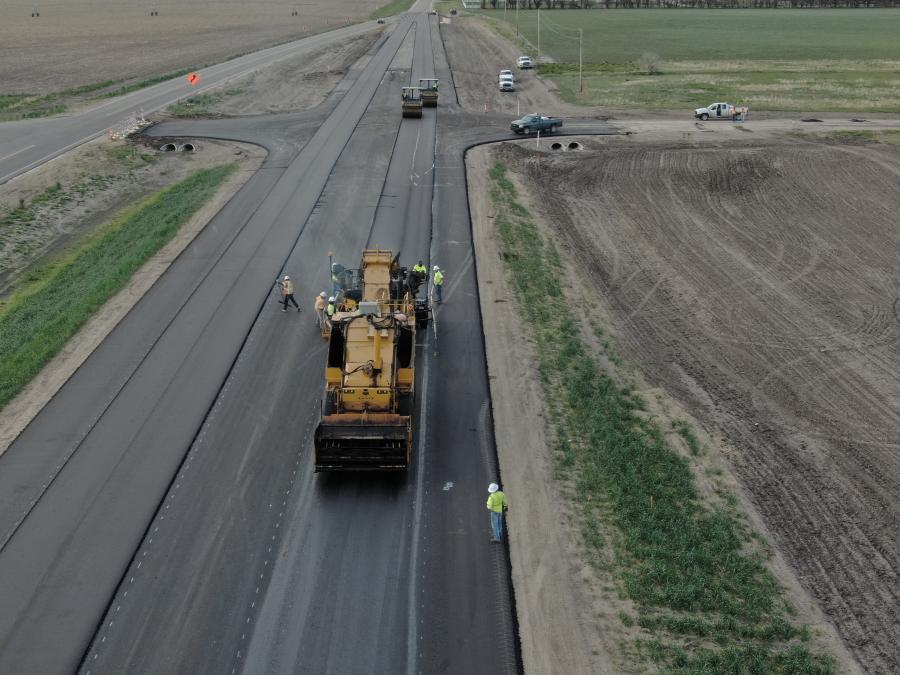The new road required 240,000 tons of asphalt. The asphalt was produced by a portable plant brought into nearby Dickerson specifically for the job.
(KDOT photo)
It looked like an easy job. The project called for a 15.5-mi. highway to be built across the flat Kansas prairie where no road had been before. No traffic to contend with. No hills to flatten. No web of utilities and fiber optics to relocate.
Hold the combines a minute. As all experienced contractors know, even the jobs that look easy can be challenging.
When lead contractor Bob Bergkamp Construction and subcontractors including APAC Shears began looking closely at constructing K-14 in Rice and Reno counties, they saw it was not as easy as it might appear at first glance.
First, the road needed to be raised 5 ft. to prevent future flooding.
Second, the proposed path for the two-lane road led across sandy soil. It was hardly ideal to support a highway that would carry motorists, truckers and massive farm equipment that would be traveling this road.
The new road will bypass the communities of Sterling and Nickerson. It also will carry traffic to Hutchinson, an important community in the region that also is home to the Cosmosphere, a space museum and STEM education center.
The $82 million road project began in 2020 and is scheduled to be completed this summer. The newly built roadbed would support a four-lane road, should one be necessary in the future. K-14 will have off ramps for Sterling and Nickerson.
The new road is 24 ft. wide with shoulders 8 ft. wide. The project required approximately 4.5 million cu. yds. of contractor furnished fill dirt and 300,000 cu. yds. of common excavation.
"This area is primarily sandy soil across the Arkansas Valley river basin," said Loren Schroeder, project manager of Bergkamp. "We wanted to minimize the number of borrow pits required so we brought in a dredge to excavate 50 to 60 feet deep and acquire the material we needed. The pits were strategically located close to major interchanges where large amounts of material were needed. We used the dredge to bring up the sand, put it into trucks and then route it to all parts of the road project."
Clay was used in the top 18 in. of subgrade and the top 6 in. of subgrade also required cement stabilization, which Bob Bergkamp Construction performed. Bob Bergkamp Construction used Trimble Total Station Machine Control to achieve precise vertical and horizontal alignment.
Pavement Mix
The new road required 240,000 tons of asphalt. The asphalt was produced by a portable plant brought into nearby Dickerson specifically for the job.
Once the subgrade issues were solved, the construction team from APAC Shears built a 10-in.-thick dense-graded pavement. The road was topped with a Superpave mix, which is used for interstates across the country.
The road design called for a 6-in. base and 2.5-in. intermediate course with polymer-modified asphalt cement. The road and shoulders were topped with a 1.5-in. layer. The shoulders were 6-in. thick, capable of supporting traffic when repairs of the mainline road become necessary in the future.
The asphalt mix used limestone that came from more than two hours away by truck.
Technology
The project utilized cutting-edge technology. While one of Kansas's most famous fictional characters could have used his x-ray vision to determine the exact depth and composition of the mix, Kansas DOT (KDOT) requires more verifiable proof.
The paving team also used a Tiny Mobile Robot to lay out the paving. The robot uses GPS to paint lines to follow with increased accuracy.
"This system works well and is very convenient," said Tom Stivers of APAC Shears.
His team handled the paving part of the job.
"It sure beats having to set up 100 miles of stringline to follow."
Stivers likes the accuracy of the equipment, but also favors the man hours saved.
"It's no secret that it is difficult to get the right people for our jobs. The old way can take two to three people full time to do testing of the finished road. This equipment requires just a single skilled person."
Another piece of technology that Stivers saw is the proliferation of electric powered equipment — not just vehicles.
"One Friday I saw another contractor get out of his truck and pull out a Stihl saw to cut off a piece of asphalt," said Stivers. "It was an electric saw, with no wires, of course. He used it to easily cut off a piece of asphalt."
Green technology is becoming influential in the construction industry. But perhaps the greenest technology is an old practice.
"We incorporated 15 percent recycled asphalt products [RAP] into our road mix," said Stivers. "KDOT allowed us to do that because it is a great product and makes good sense economically."
RAP is primarily composed of ground up pavement from old road projects. Often a rejuvenating mixture is added, and the old asphalt and rock are ready to live again as a new road.
Stivers and his team feel a sense of satisfaction as the project is getting ready to open to traffic in a few weeks.
"My family has been hearing me talk about this job for a long time," he said "It will be fun for them to get to drive on it. But I know it will be great for local people to get on it as well. The road will be a time saver for everyone and a lot safer too." CEG
Chuck MacDonald
Chuck MacDonald is an editor, blogger and freelance feature writer whose writing adventures have taken him to 48 states and 10 countries. He has been the editor for magazines on pavement construction, chemicals, insurance and missions. Chuck enjoys bicycling, kayaking and reading. He graduated from the University of Missouri with a degree in journalism. Chuck lives in Annapolis, Md. with his wife Kristen. They have seven grandchildren.
https://www.linkedin.com/in/chuckmacdonald/ Read more from Chuck MacDonald here.
Today's top stories






















